I guess the little black bees (see photo below) are no strangers to you, as they are so common in Sabah. They seem to nest anywhere that has cavity, like tree hollow, even wooden houses. They usually make a wax-like exit tunnel for the hive. When I was a naughty boy, I just couldn’t help to pinch the tunnel to close the exit, though they are gentle and harmless.
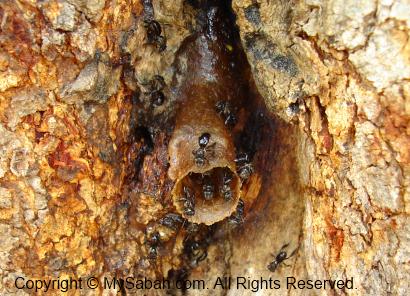
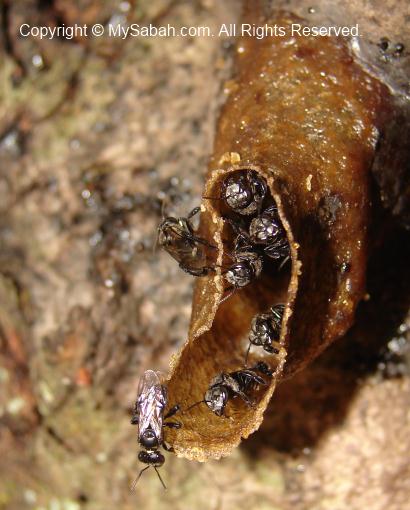
In one occasion, I was told that they are “stingless bees” (Trigona spp). FYI, Chinese calls it Mi Zai (蜜仔). When stingless bees got agitated, they don’t sting. Instead, they secrete something sticky and make my hair stick together. I didn’t pay much attention to them, because they are so ordinary and abundant.
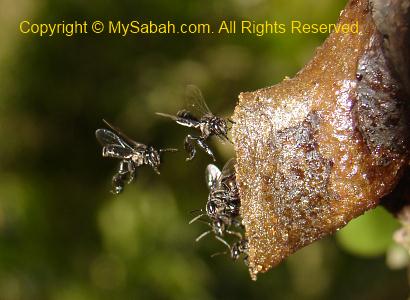
One day I passed by a house in Kiau Nuluh Village and saw a few log, each with a small opening.
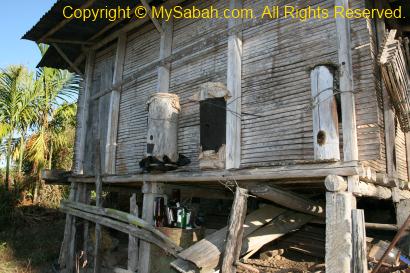
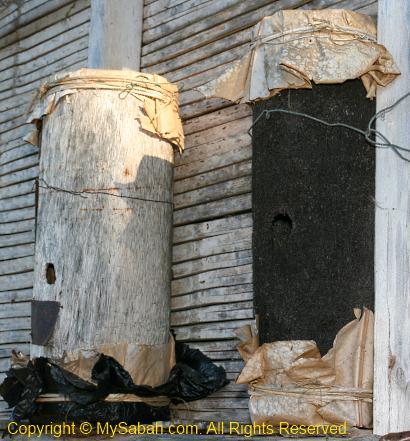
Another closer look of the log. Actually they are hollow log (usually coconut trunk) for bee farming. The locals call this empty log “Gelodog”.
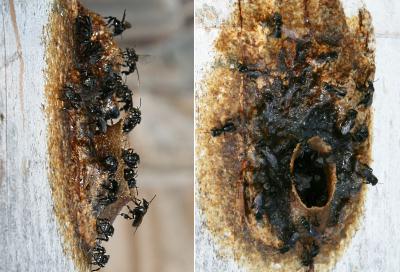
However, to my surprise, they are not farming honey bees, they farm stingless bees instead. It was early in the morning and most villagers have gone to work in their plantation, so I could not turn to anyone for answer. I wonder why they rear such a small bee species. Aren’t larger honey bees more productive? Later I met a bee expert, Mr. Salim Tingek, who is one of the authors for the book “Honey Bees of Borneo”. He told me that the honey produced by stingless bee is sour and even bittern in taste, but its honey has better medical values, with functions still not being well-known to most researchers. As stingless bees are a lot smaller than honey bees, they may have access to smaller flowers such as herb. His studies are mainly focus on commercial honey bees, so he advised me to ask the locals for more details.
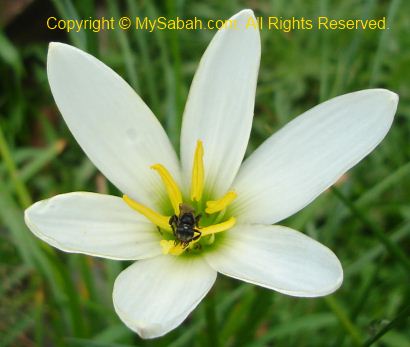
Searching on the Internet, I found a bit of info from a propolis bee farm at the Penang Botanical Garden. They breeds stingless bees (in fact only Malaysia doing this) to get the propolis which can “promote healing and regeneration of tissues. It has antibacterial, anti-inflammatory functions and protect the body from oxygen free radical damage, …useful as healing agent and application for home remedies such as honey, soap and balm”. That’s all I know at this moment. Now at least I know stingless bee is an extraordinary bee.
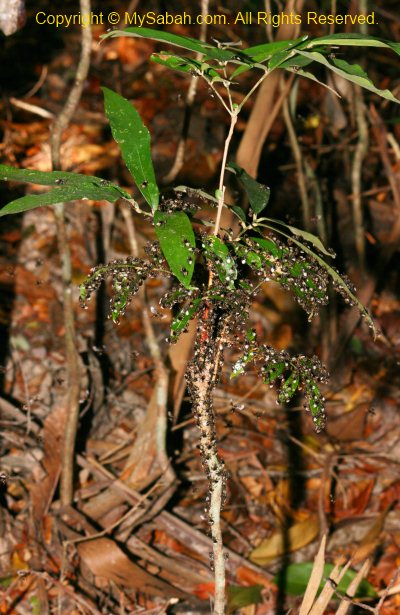
Last month in a jungle trek in Gaya Island, I saw hunderds of stingless bees gathered on a small tree, which is next to their hive.
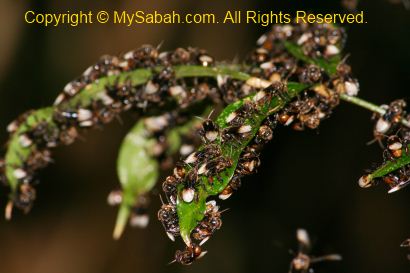
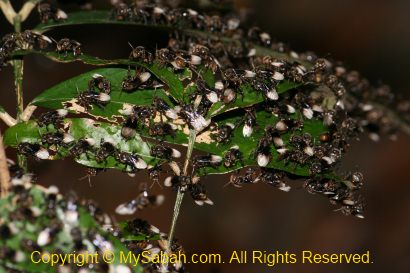
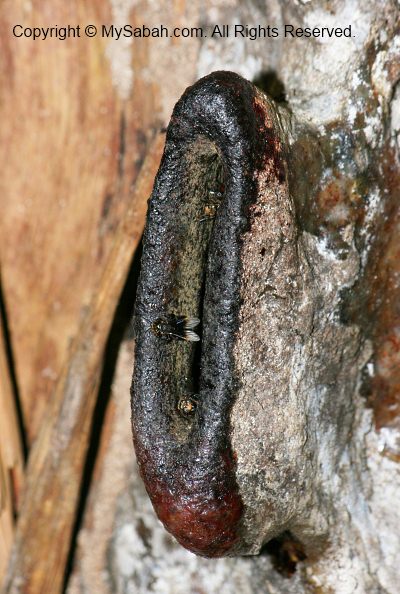
It was quite an interesting phenomena, but I have no idea what they were doing. This specie has every big exit tunnel.
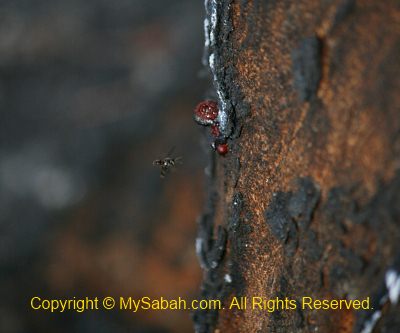
Due to the forest fire caused by drought, many bees lose their home. Above is a photo of stingless bee rebuilding its home on a burnt tree.
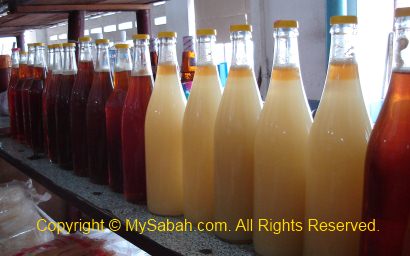
Talking about honey bees, probably I can share something I learn from the honey bee experts (Nikolaus Koeniger, Gudrun Koeniger and Salim Tingek). There are five species of honey bees in Borneo. One of them is Apis nuluensis(nulu means Mountain in Dusun language), a new species endemic to Sabah. They found its nest in a tree hollow near Laban Rata. There are 9 species ofApis honey bees in the world. The dominant honey bee species of Sabah isApis koschevnikovi.
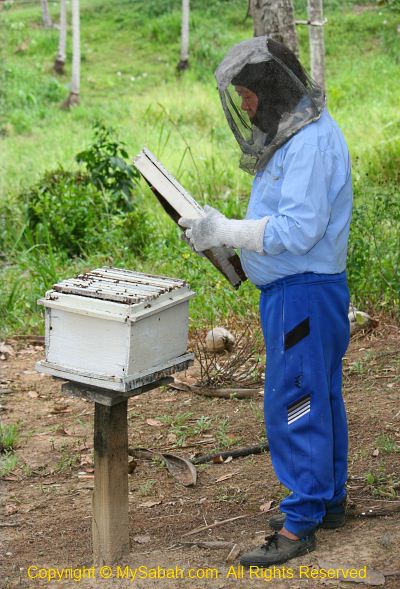
Apis cerana is the most common honey bee species being farmed (domesticated) in Sabah. In Kudat you can find many bee farms around and they have become tourist attraction of villages. The most famous honey bee farm of Sabah is located in Kampung Gombizau.
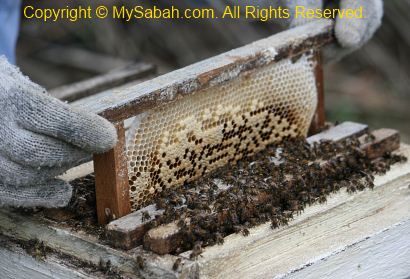
The “Gelodog” (hollow log) bee farming method is destructive, as you may damage the bee hive when you open the cover to collect the honey. The more sustainable method is by using Movable Frame Hive (like photo above).
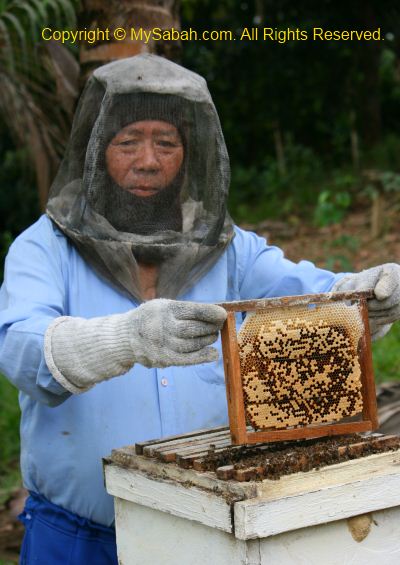
Apis cerana honey bee is an Asian bee species, and it is not as famous as the European bee such as Apis Mellifera. We pay RM40, 50 to buy a small bottle of imported honey, even though our local honey bees also produce high-quality honey. Our environment is cleaner and more nature than the western countries. By right, our honey is better. We only don’t package our honey and turn it into a $ound brand.
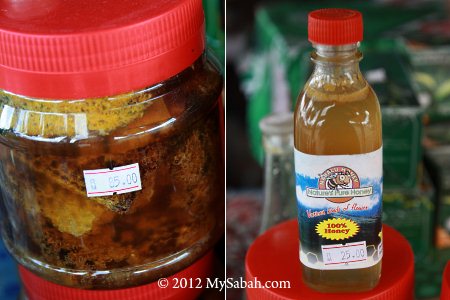
Pic: a small bottle of Sabah honey (right) can cost MYR25 (≈USD8.33), expensive, but still cheaper than imported honey.
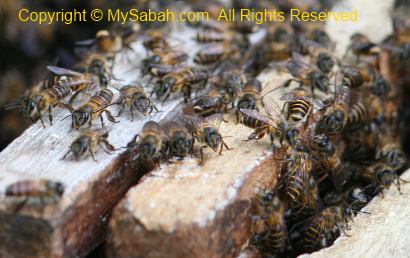
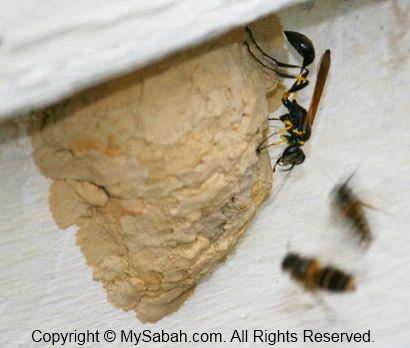
Photo above: unwelcome guest detected by honey bees. Many natural predators and thieves are eyeing for the sweet honey and want to get a share. Besides stinging, honey bees have many ways to deal with enemies. Like the “sticky ring” next to the hive of Apis andreniformis bees, ants and other bugs who want to approach the hive will be glued. The powerful mandible of drone (soldier bee) can chew off their heads too.
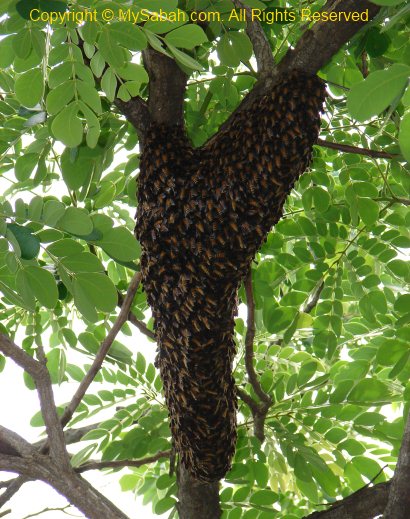
Here comes the most famous bee of Sabah, Apis Dorsata. This largest wild honey bee of Sabah is not only famous for its honey, but also its aggressiveness. Chinese calls it “Ba Gong Mi” (八公蜜) and this bee means horror. Stealing honey from these bees brings death penalty. I sweated when a bee expert showed a photo of her only 2 feet away from the dorsata swarm. She says it is ok, because the swarm is looking for a nesting site so the bees are not in the mood of protecting honey. I can’t read bee language so I will never dare to try that. I advise you not to too..
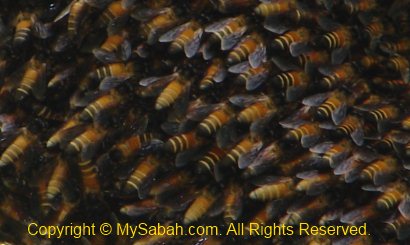
Apis dorsata specie is not a suitable candidate for bee farming, as they are not cavity dwellers. For safety and easier navigation, they love to build their hives high on tree, especially tall Menggaris tree. But my God, this bee seems to love to nest on Rambutan fruit tree too. Village kids like to throw stone to pluck Rambutan and that’s how they hit the jackpot by accident. Some locals hunt for their honeycomb and very likely the wild honey you buy in local market is from A. dorsata (or Apis cerana). The bee larvae is also edible. My mom tried it before and say it tastes like milk. Very healthy food I suppose.
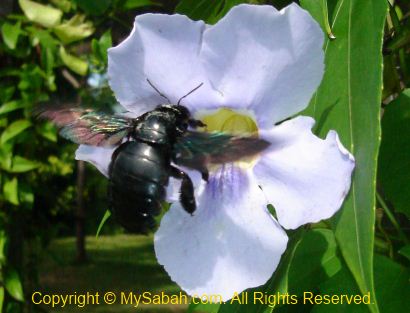
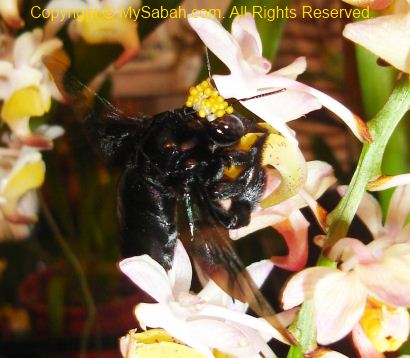
The big black bee (anyone knows its name?) was used to be the bee I feared the most. Later I found that it is very gentle and rarely attacks people. The only thing I know about it is this bee likes to drill a hole on the wood and nest inside, and it doesn’t live in group. Now I find it very cute. Oh Bee-Bee…
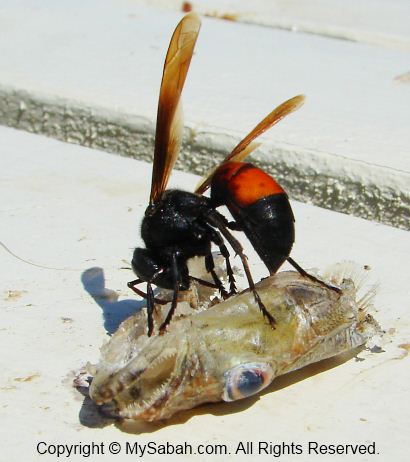
Ok, this one is a hornet, not a bee. If you see a rat corpse without eyes, that’s the work of this hornet. So far I haven’t seen any of them harvesting nectar, so I assume they like rotten meat. For those who do fishing in the wild, you better cover the fishes and bait, otherwise you will find many hornets come and feast on them. Anyway, it is quite safe to get near to them, as long as its nest is not somewhere nearby. Chinese calls it Tiger Head Bee (虎头蜂). Its bright orange stripe is a clear warning. Everyone, who was stung by this hornet, says it scores 10 of 10 out of pain scale and the wound may leave a permanent scar. Imagine if you are stung by hundreds of them. The only way to escape the attack from swarm of hornets is to jump into the water, no matter you know how to swim or not. It is far more better to drown rather than being stung to death by hundreds of hornets.
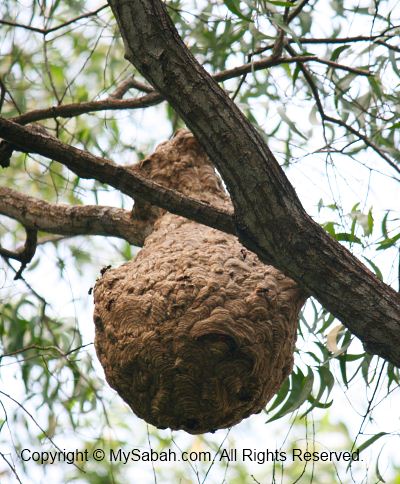
Honey bees die if they sting, because they detach the sting that is linked to vital organs, this is not the case for hornets. Many even call them killer bees. Hornet hives are very common on the trees of countryside. If you come too near, they will send a few patrolling hornets to check on you. It is important that you slowly walk away from their hive and don’t do anything stupid that makes them perceive you as a threat.
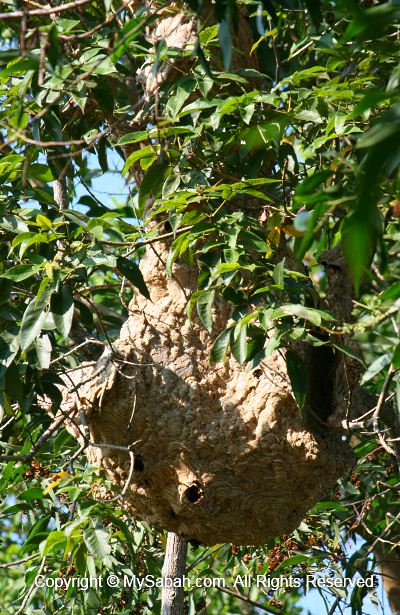
Hornets like to nest on the tree, inside the shrub, under the roof and cliff. Their nests are very beautiful. However, after some days, the nest will grow from fist size to size of sandbag (or even bigger!). That’s how they get another name, i.e. Sandbag bee (泥包蜂 in Chinese). If you see their nest, don’t try to chase them away by boxing their hive like sandbag or fight them with mosquito insecticide. Just call the Fire Department, they know about to eliminate the nest (and it is a free service).
Can’t believe I can write so much about bees, hope you enjoy reading this…
Tidak ada komentar:
Posting Komentar